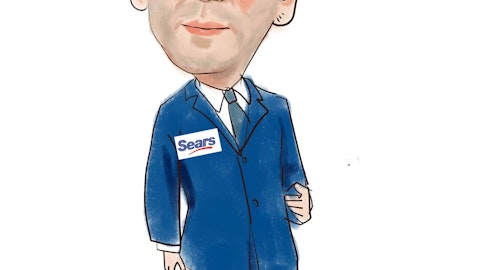According to a recent financial outlook for the second quarter fiscal 2015 earnings from Sears Holdings Corp (NASDAQ:SHLD), the company is expecting to cope-up its financial position in the upcoming period. However, the investors are not impressed with the announcement with the shares of the retailer dropping 6.32% in the early-morning trading session. The retailer is expecting its second quarter adjusted negative EBITDA to range between $189 million to $249 million, which is better than prior year negative EBITDA of $298 million. Sears is expecting to announce second quarter net income attributable to its shareholders in the range of $155 million to $205 million, which amounts between $1.46 and $1.92 per diluted share. These figures are way below the market’s earnings expectation of $3.21 per share over revenue of $5.91 billion. Sears Holding will announce its second quarter fiscal 2015 financial results on August 20.

Despite these financial restructuring efforts from Sears Holdings Corp (NASDAQ:SHLD), what is more worrisome is a drop of 10.6% in its Comparable store sales in this quarter. The sales at Sears Domestic were down 13.9% quarter-to-date, whereas the sales at Kmart have declined 6.9% during the same period. On the positive front, Sears Holdings Corp (NASDAQ:SHLD) is expecting a cash deposit of $1.8 billion along with $1.2 billion in domestic credit facility at the end of the quarter against previous quarter figures of $600 million and $200 million, respectively. The company was able to extend its domestic credit facility to $3.28 billion out of which, $2.0 billion will mature in 2020 and the remaining $1.3 billion will mature after April 2016 only.
The retailer sold off its real estate assets to Seritage Growth Properties (NYSE:SRG), a real estate investment trust spun off from Sears Holdings earlier this year, fetching $2.7 billion from of the sale. Seritage Growth bought 235 Sears and Kmart stores under the transaction along with Sears’ 50% interest in 31 other properties. Out of these stores, Sears Holdings is renting 224 properties, whereas the others are leased out to other companies. Ken Griffin’s Citadel Investment Group was among the first investors to disclose a stake in Seritage Growth Properties, with a reported ownership of 2.39 million Class A shares of the company representing 9.7% of the outstanding stock. Bruce Berkowitz’s Fairholme is another shareholder with a large stake in the REIT, which contains 3.25 million shares.
The shares of Sears Holdings Corp (NASDAQ:SHLD) have declined 35.79% year-to-date including today’s plunge. Smart Money held a positive outlook on the retailer at the end of the first quarter, with 22 hedge funds owning $2.92 billion in the company against the previous quarter investment of $2.53 billion. The value of the aggregate investment grew significantly because of the growth in Sears’ share price amounting to 25.47% during the first quarter. At the end of the first quarter, Edward Lampert’s ESL Investments was the largest shareholder of the company with 26.44 million shares valued at $1.09 billion. Murray Stahl’s Horizon Asset Management and Robert Jaffe’s Force Capital were among other main shareholders of the company at the end of the first quarter.
Considering the current financial volatility within the company and the market alike, we would recommend investors to wait until the financial results and start a position afterwards only.
We don’t just track the latest moves of funds. We are, in fact, more interested in their 13F filings, which we use to determine the top 15 small-cap stocks held by the funds we track. We gather and share this information based on 16 years of research, with backtests for the period between 1999 and 2012 and forward testing for the last 2.5 years. The results of our analysis show that these 15 most popular small-cap picks have a great potential to outperform the market, beating the S&P 500 Total Return Index by nearly one percentage point per month in backtests. Moreover, since the beginning of forward testing in August 2012, the strategy worked brilliantly, outperforming the market every year and returning 123%, which is more than 60 percentage points higher than the returns of the S&P 500 ETF (SPY) (see more details).
Disclosure: none





